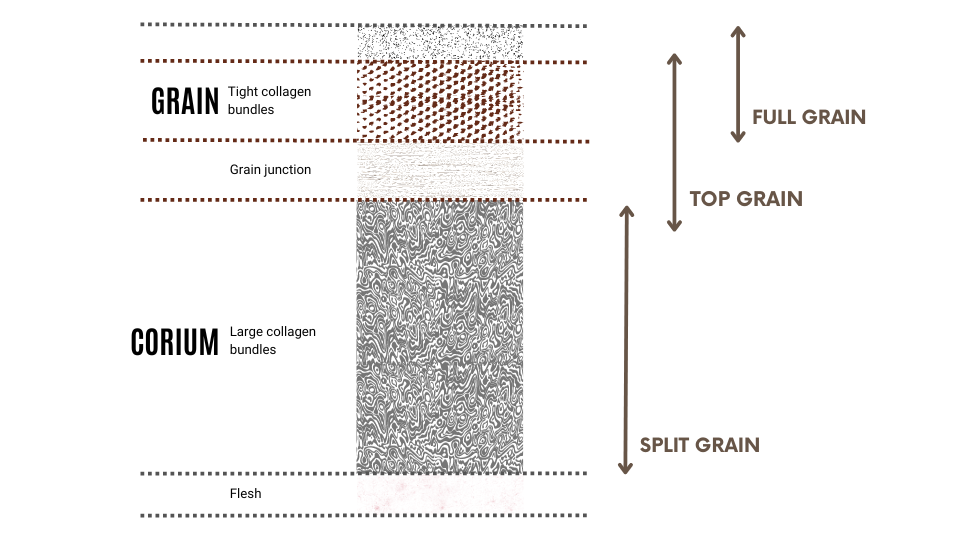Understanding Leather: Your Guide to Choosing the Right Belt
Understanding Leather: Your Guide to Choosing the Right Belt

Full-Grain Leather Is the Best Quality
Full-grain leather stands atop the hierarchy of leather grades. With its luxurious, smooth surface and minimal flaws, it’s highly sought after. Unlike other grades, full-grain leather hasn’t undergone sanding or buffing to remove imperfections, allowing its natural grain to remain intact. This results in stable and durable fibers, ensuring longevity. Additionally, full-grain leather develops a coveted patina over time, offering protection against wear and tear while enhancing its aesthetic appeal.
Aniline and Semi-Aniline Finishes
Full-grain leather can be further classified into two finished product types: aniline and semi-aniline. Aniline leather, the epitome of luxury, is dyed using soluble dyes without concealing its natural surface. On the other hand, semi-aniline leather features a thin protective coat for added stain resistance without compromising its natural appearance.
Top-Grain Leather Is the Most Common
Following closely behind full-grain leather, top-grain leather is prevalent in the market. Its pliability and thinner profile make it a popular choice for various leather products. Unlike full-grain leather, top-grain leather undergoes sanding and receives a finish coat, giving it a slightly cooler, plastic-like feel. Despite these alterations, top-grain leather still develops a patina over time, ensuring durability and resistance against damage and corrosion.
Genuine Leather Is Not a Statement about its Authenticity
Contrary to what its name implies, genuine leather doesn’t denote superior quality. Instead, it refers to real leather products, albeit of lower quality compared to full-grain and top-grain leather. Made from leftover hides after premium products are crafted, genuine leather lacks the refined appearance and durability of its counterparts. However, its affordability and wide availability make it a popular choice for budget-conscious consumers.
Corrected-Grain Leather Has Corrected Imperfections
Corrected-grain leather, often referred to as the lesser-known grain, undergoes correction by skilled leatherworkers to enhance its functionality and appearance. Hides that don’t meet the standards for aniline or vegetable-tanned leather are used to create corrected-grain leather. Through embossing, sanding, and dyeing, imperfections are corrected, resulting in a uniform surface. While it may lack the natural characteristics of full-grain leather, corrected-grain leather offers affordability and availability, making it a practical choice for many.
Frequently Asked Questions
Is full-grain leather the most durable?
Full-grain leather is indeed highly durable due to its natural grain and minimal processing, making it resistant to wear and tear over time.
What is the difference between top-grain and full-grain leather?
Top-grain leather undergoes sanding and receives a finish coat, whereas full-grain leather retains its natural surface, resulting in differences in texture and appearance.
Are genuine leather products of inferior quality?
While genuine leather products are made from real leather, they are generally of lower quality compared to full-grain and top-grain leather.
Does corrected-grain leather lack durability?
Corrected-grain leather, while not as durable as full-grain leather, still offers reasonable durability and is suitable for various applications.
What are the benefits of aniline and semi-aniline finishes?
Aniline finishes preserve the natural appearance of leather, while semi-aniline finishes offer added stain resistance without compromising its beauty.
Where can I find high-quality leather products?
High-quality leather products, especially those made from full-grain or top-grain leather, are available from reputable retailers and craftsmen specializing in leather goods.
In conclusion
Understanding the four basic types of leather and their respective qualities is essential for making informed purchasing decisions. Whether you’re in the market for high-end luxury or seeking affordability and availability, there’s a type of leather to suit your needs. By considering factors such as durability, appearance, and price, you can find the perfect leather products to complement your style and lifestyle.

